Key takeaways:
- Dynamics and instrumental roles are crucial for creating emotional connections and depth in music arrangements.
- Effective arrangements rely on strong melodic hooks, harmonic support, and rhythmic variation to maintain listener interest.
- Common mistakes include neglecting dynamics, overcrowding arrangements, and adhering too strictly to conventional structures, hindering creativity.
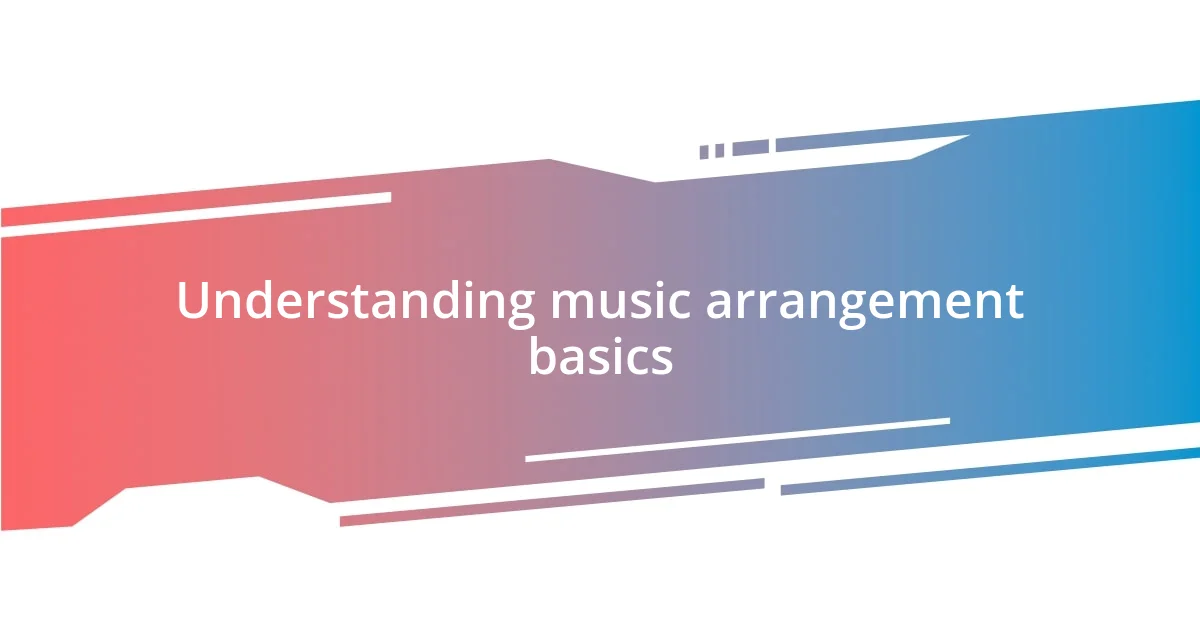
Understanding music arrangement basics
When I first delved into music arrangement, I was fascinated by how a single melody could transform through different instrumental textures and layers. I often wondered, what makes one arrangement more compelling than another? The answer lies in understanding the balance of elements like harmony, rhythm, and instrumentation to create a cohesive musical story.
One of the key basics I’ve learned is the importance of dynamics. In my early arrangements, I remember having all my instruments play at the same volume, which made the piece feel flat and lifeless. Once I started experimenting with crescendos and decrescendos, I realized how these subtle changes could evoke emotions, making my audience feel more connected to the music.
Additionally, I find that considering the role of each instrument is crucial. For instance, I love incorporating unexpected instruments; doing so sparks creativity and keeps the arrangement fresh. Have you ever underestimated a simple instrument? I did, with the triangle. It might seem trivial, but when used at the right moment, it can add a brilliant sparkle to an arrangement that elevates the entire piece.
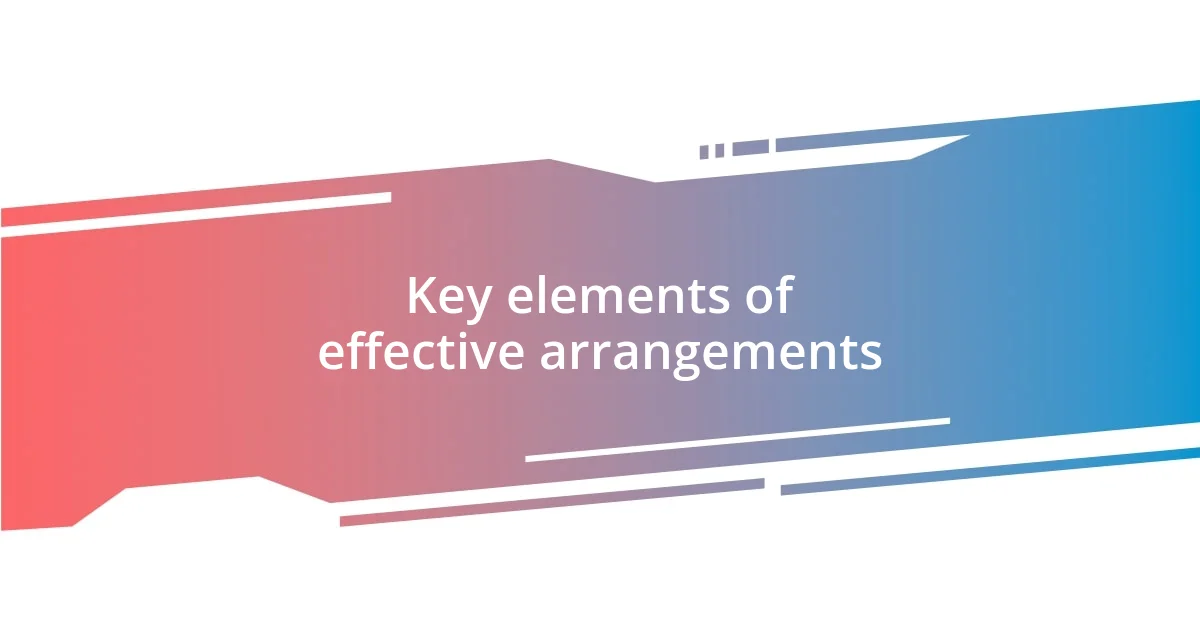
Key elements of effective arrangements
The structure of an arrangement often hinges on its core elements, which can guide the listener’s journey. For me, developing a strong foundation through strong chords and memorable motifs was a game-changer. I remember crafting a piece that initially lacked direction until I layered a simple but captivating motif over the harmonic structure; it instantly transformed the arrangement, providing it with an anchor and inviting listeners to engage more deeply.
Here are some key elements I focus on for effective arrangements:
- Melodic Hooks: A catchy melody is essential; it should be easy to remember and sing along to.
- Harmonic Support: I often experiment with varied chord progressions that complement the melody and enhance emotional impact.
- Instrumental Colors: Using a mix of instruments, especially those with unique timbres, can add richness and depth.
- Rhythmic Variation: I enjoy playing with syncopation and changing time signatures to maintain interest throughout the piece.
- Space and Silence: I’ve found that letting moments breathe with silence can heighten tension and anticipation.
- Dynamic Contrast: Shifting between soft and intense passages often leads to a more compelling narrative arc.
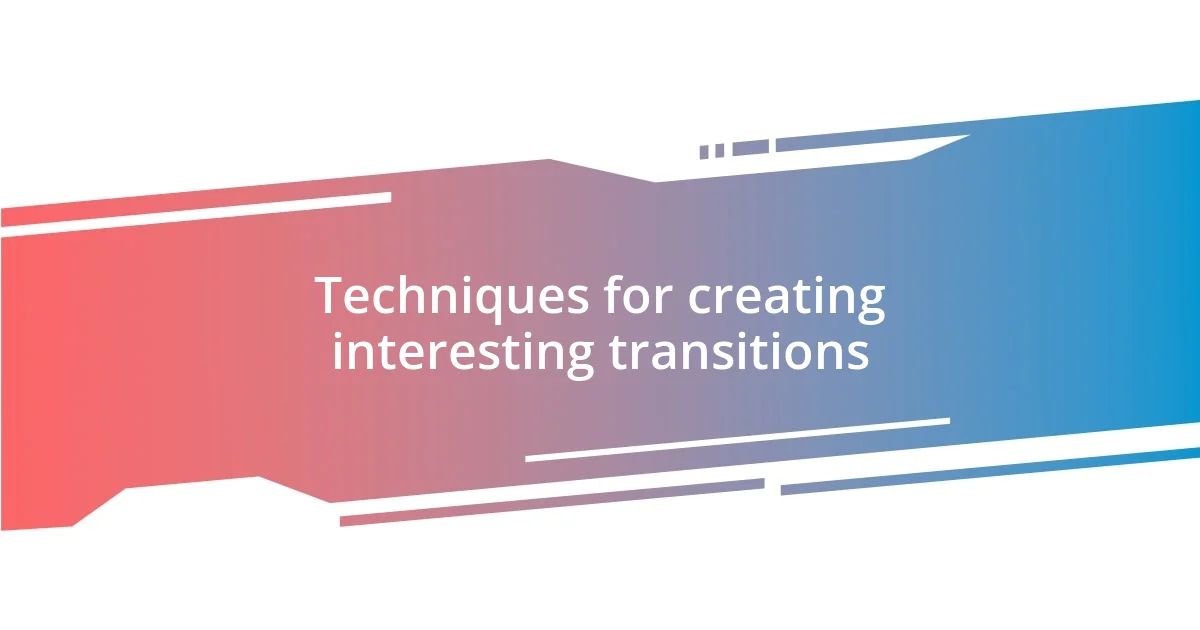
Techniques for creating interesting transitions
Creating interesting transitions in music arrangement can really elevate the listening experience. One technique I often use is building tension before a big change. For instance, I might start a passage softly, then gradually layer in more instruments, leading to a powerful drop or shift. It feels like a rollercoaster ride, and I’ve found that it makes the transition memorable. You know that moment when the music swells just before a crescendo? It’s thrilling!
Another favorite method of mine is to utilize tempo shifts. When I experiment with slowing down or speeding up the tempo before a major transition, it not only enhances the moment but also gives the listener a brief pause to catch their breath. I once created a piece where I slowed the tempo significantly before a big reveal, and the impact was undeniable. It felt as if time itself had slowed, heightening the anticipation and drawing my audience in even more.
Lastly, I can’t stress enough the value of melodic motifs. By revisiting a melody in a different key or with alternate instrumentation during a transition, I create continuity while refreshing the listener’s experience. I remember incorporating a familiar melody in a minor key right before a shift; it was like a secret handshake that made the next section feel like home, yet new at the same time. Have you ever noticed how a small change can shift the entire mood of a piece? That’s the magic of transitions!
| Technique | Description |
|---|---|
| Tension Building | Gradually increasing intensity before a shift creates anticipation. |
| Tempo Shifts | Changing speed before transitions allows listeners to prepare for progressions. |
| Melodic Motifs | Revisiting familiar melodies in different contexts creates continuity and surprise. |
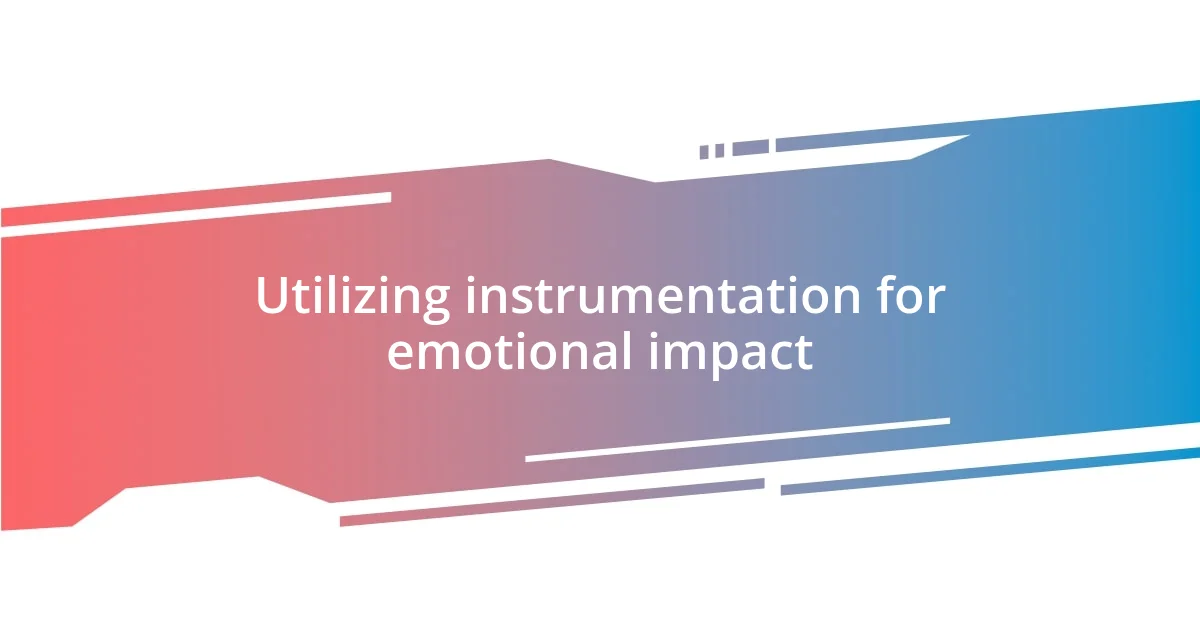
Utilizing instrumentation for emotional impact
When it comes to utilizing instrumentation for emotional impact, I believe in the power of diverse timbres. Each instrument carries its own personality, and I often pick ones that resonate with the feeling I want to evoke. For example, the warmth of strings can stir nostalgia, while the sharpness of a brass section can inject excitement. Can you recall a moment in a film where the strings swell, pulling at your heartstrings? That’s the magic of instrumentation—tailoring it to sculpt emotional landscapes.
I’ve found that the layering of instruments can amplify feelings remarkably. Once, during a project, I used a gentle piano melody beneath a soaring violin line; the combination created a sense of yearning that was palpable. It was as if the piano whispered secrets while the violin gave voice to dreams. Have you ever noticed how the right instrumental combination can paint an entire scene? It’s a bit like painting with sound, where every brushstroke adds to the story.
Beyond just choosing instruments, dynamics play a crucial role in emotional expression. I remember arranging a piece where I alternated between hushed passages and grand, sweeping crescendos. This dynamic contrast not only kept the listener engaged but also mirrored the highs and lows of human emotion. Isn’t it fascinating how subtle shifts in volume can convey a character’s internal struggle? Each swell and drop becomes a heartbeat of the arrangement, giving the piece a pulse that resonates deeply with anyone who listens.
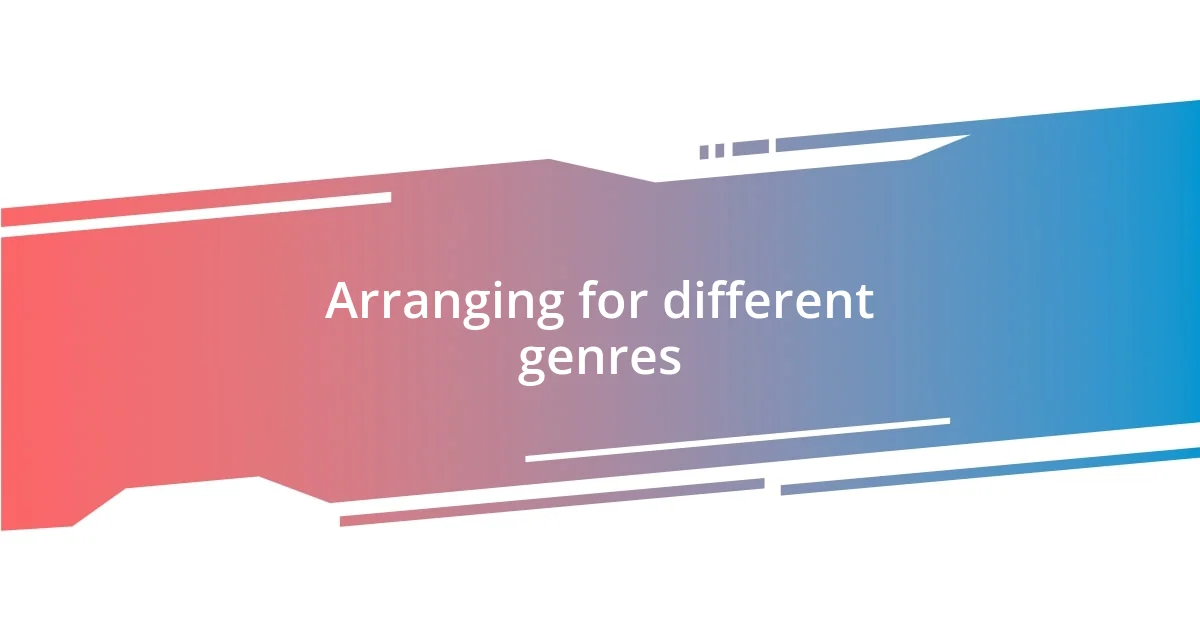
Arranging for different genres
When I approach arranging for different genres, I find that each style has its unique language. For example, in arranging for jazz, the use of syncopation and improvisation is crucial. I remember a time when I was working on a jazz piece and decided to leave space for a solo that let my musician’s personality shine through. It felt like giving them the stage to tell their own story, and that spontaneity is what jazz is all about, don’t you think?
Switching gears to pop music, the arrangement tends to focus heavily on hooks and catchy melodies. I once created a pop track where I structured the chorus to be an earworm that lingered long after the song ended. I found that the balance of energetic beats and memorable lyrics creates an irresistible invitation to dance. Have you ever noticed how a good chorus can turn a song into an anthem? It’s that blend of simplicity and vibrance that makes pop arrangements so engaging.
In stark contrast, when I venture into classical arrangements, I embrace complexity with rich harmonies and intricate counterpoint. I had an experience arranging a string quartet where the interplay between the instruments created a conversation, each voice complementing the others while telling its own tale. It’s a meticulous process, but the end result is often breathtaking. Isn’t it fascinating how classical music can evoke so much emotion through variations in harmony and texture? Each genre brings its flavor, and that diversity is what makes music a universal language.
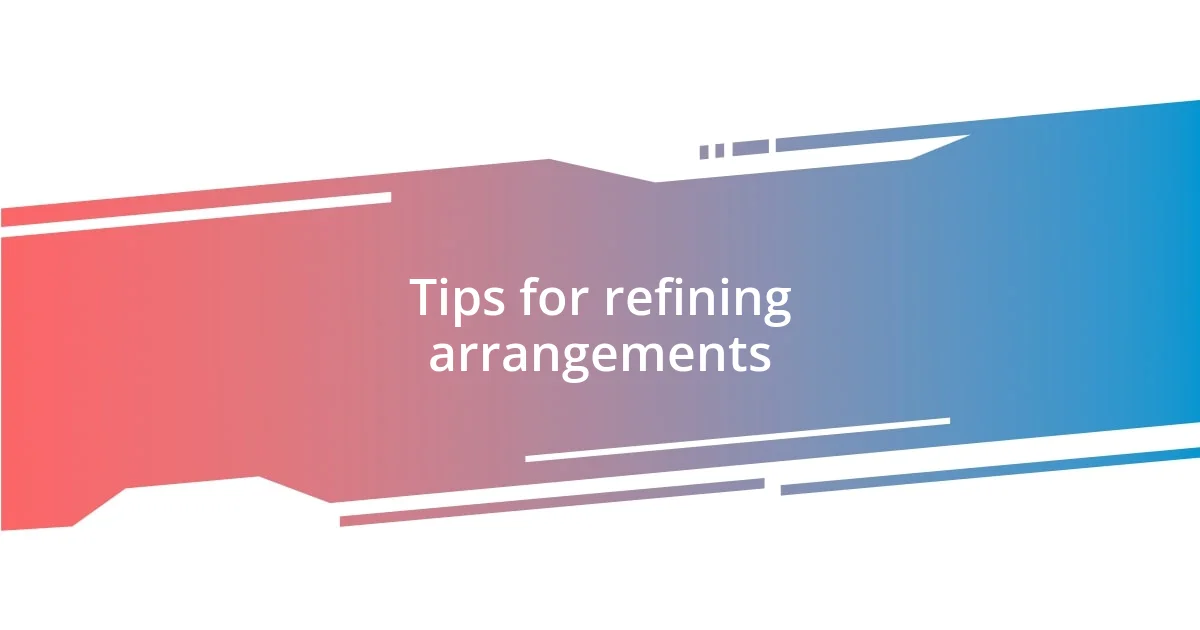
Tips for refining arrangements
One of my favorite tips for refining arrangements is to actively listen to the piece from a listener’s perspective. Early in my musical journey, I recorded a draft and played it back while doing other chores around the house. This simple act allowed me to notice subtle shifts and areas that felt off; it’s amazing how our ears can catch what our eyes miss while actively involved in creating. Have you ever stepped away from a project only to return with fresh ears and newfound clarity?
Another technique I find effective is to experiment with different sections of the arrangement. I often take a specific phrase I love and try inserting it in various points throughout the piece. There was a time when I had a catchy melody that I initially placed in the chorus but found it made the bridge feel more engaging instead. It was like discovering a hidden gem; the entire song shifted in energy for the better. Don’t you think it’s fascinating how a little tweak can breathe new life into a familiar arrangement?
Finally, seeking feedback from fellow musicians can provide invaluable insights. I remember sharing a rough arrangement with a friend who had an ear for detail. His suggestions to simplify a convoluted section turned what felt like a tangled mess into a smooth, flowing melody. It’s a reminder that collaboration isn’t just about sharing the workload; it’s about enhancing the overall vision together. Have you ever found that outside perspective sparks inspiration that you hadn’t considered?
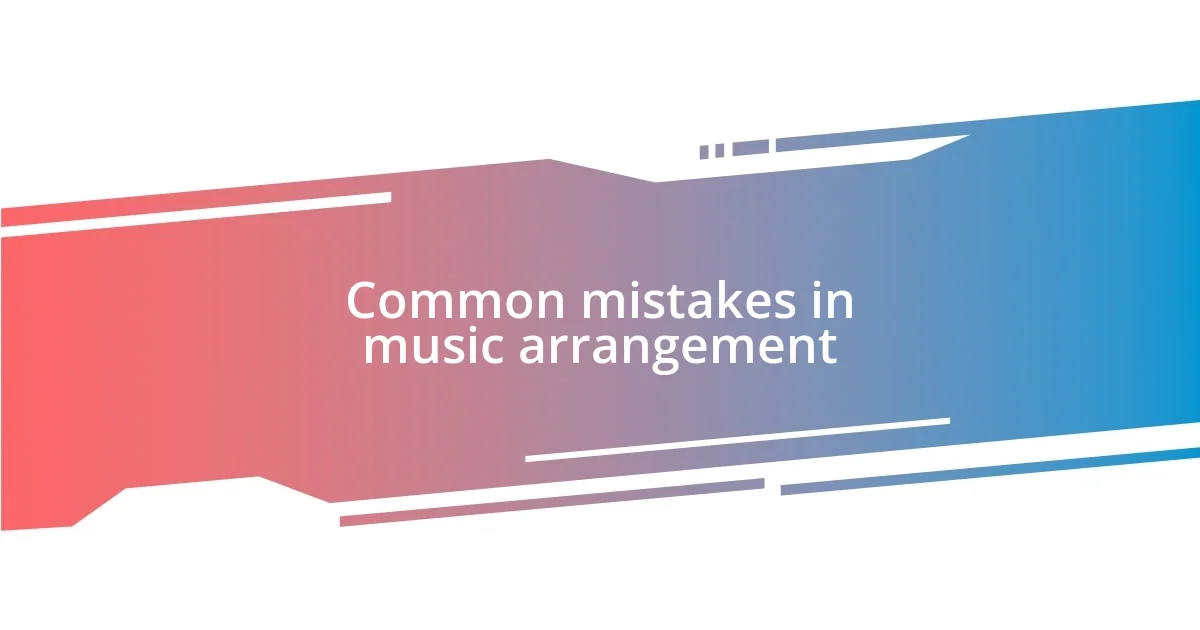
Common mistakes in music arrangement
When it comes to music arrangement, one common mistake I see is neglecting the importance of dynamics. I remember pushing a track out without varying the volume and intensity, thinking the notes alone would do the work. The result was a flat piece that lacked emotional impact. Have you ever noticed how a well-placed crescendo or decrescendo can draw listeners into the music? Dynamics breathe life into an arrangement, making it feel more like a journey.
Another pitfall I’ve encountered is overcrowding the arrangement with too many instruments. Early in my career, I thought more was always better, leading to a muddled sound. I recall one arrangement that felt chaotic rather than cohesive; it became clear that sometimes, less truly is more. Don’t you agree that allowing space for each instrument to shine often results in a clearer and more powerful piece?
Finally, I think it’s critical to avoid sticking too rigidly to a formulaic structure. I once had a song that followed a predictable verse-chorus-verse pattern, and while it was comfortable, it didn’t ignite any excitement. I started experimenting with unconventional transitions and unexpected bridges. The outcome was refreshing and captivating. Isn’t it intriguing how breaking the mold can lead to more innovative and memorable music?















